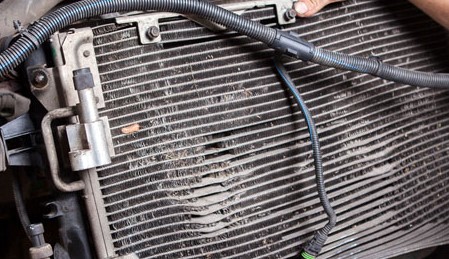Your car’s engine burns fuel and creates energy. This generates heat and it is important to vent this heat away from the engine parts to prevent damage. Radiators do this job of eliminating heat from the engine. When the thermostat detects excess heat, the radiator releases coolant, which travels through the engine to absorb heat. Once the heat is absorbed, the liquid is sent back to the radiator, where cold air is blown across it to cool it down, and the heat is exchanged with the outside air. In short, the radiator helps keep your car cool.
There are many factors that can cause the car’s radiator to malfunction. You will be able to notice some of the signs if the radiator is failing. The most common ones are poor quality coolant and rust.
Here are some of the signs that your radiator is failing:
Overheating
The most common and obvious sign of a malfunctioning radiator is overheating. The engine will start overheating even on regular outings. It can cause your vehicle to shut off or it may not start. Check the readings on the temperature gauge and see if they are higher than usual. If the needle points to red, it is a warning that the engine temperature is too high.
In case the temperature is only slightly higher, it may not be a cause of concern, especially during the summers. However, if the temperature stays constantly on the higher side, it could be because of a clogged radiator due to corrosion, debris, or build-up of deposit over time, which prevents the right amount of coolant from circulating through the radiator and engine. If your engine begins to overheat, you should find a safe location to pull over and let the vehicle cool down.
Leaking coolant
If your vehicle is leaking coolant, it is a sign that something is wrong. Coolant is usually a green, red, orange, or yellow liquid and if you see any such liquid pooling under your vehicle, it is likely a coolant leak. The source of the leak could be the radiator, a hose, or an issue in the engine block. Only a professional inspection can help diagnose the exact source of the leak and its severity.
Coolant contamination
As we mentioned in the previous point, vehicle coolant should be bright yellow, green, orange, or red in color. It should flow freely through the radiator and the coolant lines within the engine. However, over time, sludge and internal deposits can contaminate the coolant causing it to look rusty or the color of the oil and not the original bright color.
When the coolant is contaminated, it is usually thicker and does not easily flow through the system. It can clog up the radiator and may affect its efficacy. If your radiator is failing due to contamination, the problem should be remedied at the earliest.
Damaged or clogged radiator fins
Radiators have extremely thin and delicate fins. So, it is not uncommon that dents to occur on the fins and they flatten against the radiator. This can restrict the airflow, which in turn, affects the radiator’s ability to keep things cool.
Radiator fins can get damaged due to various reasons such as improper installation, impact from other objects or vehicles hitting your car, etc. The radiator’s external tubes can also become clogged with dirt, leaves, bugs, or other debris and this can obstruct airflow, which reduces the coolant’s capacity to cool the system.
If you see signs, and notice that your radiator is failing, you must have your vehicle checked without any delay. Ignoring radiator issues can cause extensive damage to the vehicle and necessitate expensive repairs.


